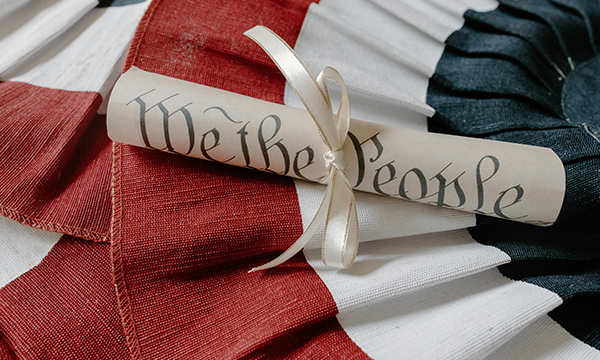By: Ah1Tom
The men had spent four months, from May to September, writing the Constitution. In the hottest months of the year; June, July, and August, those men sequestering themselves in Constitution Hall discussed and debated the language in that document. Now the draft was complete, it was time for the individual states to vote on ratification.
The first state to call a ratifying convention was Pennsylvania and now all eyes were on them. The Federalists (for the Constitution) and the Anti-Federalists (against the Constitution) had their positions printed in the papers. Passions on both sides were running high. On September 29th, when the Federalist-dominated assembly lacked a quorum to call a state ratifying convention, a Philadelphia mob, dragged two anti-Federalist members from their lodgings through the streets to the State House. In order to provide the necessary numbers, the representatives were forced to stay while the assembly voted. It was a curious example of participatory democracy.
On October 5th, Anti-Federalist Samuel Bryan published the first of his “Centinel” essays in Philadelphia’s Independent Gazetteer. Republished in newspapers in various states, the essays assailed the sweeping power of the central government, the usurpation of state sovereignty, and the absence of a bill of rights guaranteeing individual liberties such as freedom of speech and religion. Bryan was echoing the fear of many anti-Federalists that the new government would become one controlled by the wealthy established families and the culturally refined. The common working people, Bryan believed, were in danger of being subjugated to the will of an all-powerful authority remote and inaccessible to the people. It was this kind of authority, he believed, that Americans had fought a war against only a few years earlier.
The next day James Wilson, delivering a stirring defense of the Constitution to a large crowd gathered in the yard of the State House, praised the new government as the best “which has ever been offered to the world.” The Scotsman’s view prevailed. Led by Wilson, Federalists dominated in the Pennsylvania convention, carrying the vote on December 12th by a healthy 46 to 23.
Not everyone was happy about the vote. In Carlisle, on December 26th, Anti-Federalist rioters broke up a Federalist celebration and hung Wilson and the Federalist chief justice of Pennsylvania, Thomas McKean, in effigy; put the torch to a copy of the Constitution; and busted a few Federalist heads.
Alexander Hamilton, John Jay, and James Madison published the first of a series of essays; known as, “The Federalist Papers”. The 85 essays, most of which were penned by Hamilton himself, probed the weaknesses of the Articles of Confederation and the need for an energetic national government. Thomas Jefferson later called the Federalist Papers the “best commentary on the principles of government ever written.”
Against this kind of Federalist leadership and determination, the opposition in most states was disorganized and generally ineffective. The leading spokesmen were largely state-centered men with regional and local interests and loyalties. The Anti-Federalists attacked wildly on several fronts: the lack of a bill of rights, discrimination against southern states in navigation legislation, direct taxation, and the loss of state sovereignty. Many charged that the Constitution represented the work of aristocratic politicians bent on protecting their own class interests. Some newspaper articles, presumably written by anti-Federalists, resorted to fanciful predictions of the horrors that might emerge under the new Constitution. Pagans and deists could control the government; the use of Inquisition-like torture could be instituted as punishment for federal crimes; even the pope could be elected president.
One Anti-Federalist argument gave opponents some genuine difficulty–the claim that the territory of the 13 states was too extensive for a representative government. In a republic embracing a large area, Anti-Federalists argued, the government would be impersonal, unrepresentative, dominated by men of wealth, and oppressive of the poor and working classes.
By January 9, 1788, five states of the nine necessary for ratification had approved the Constitution–Delaware, Pennsylvania, New Jersey, Georgia, and Connecticut. However, the eventual outcome remained uncertain in pivotal states such as Massachusetts, New York, and Virginia. On February 6th with Federalists agreeing to recommend a list of amendments amounting to a bill of rights, Massachusetts ratified by a vote of 187 to 168. Although Massachusetts was now safely in the Federalist column, the recommendation of a bill of rights was a significant victory for the anti-Federalists. Six of the remaining states later appended similar recommendations.
When the New Hampshire convention was adjourned by Federalists who sensed imminent defeat and when Rhode Island on March 24th turned down the Constitution in a popular referendum by an overwhelming vote of 10 to 1, Federalist leaders were apprehensive about the upcoming Maryland convention. However, there was little reason to worry. The final vote on April 28th was 63 for, 11 against.
On July 2, 1788, the Confederation Congress, meeting in New York, received word that a reconvened New Hampshire ratifying convention had approved the Constitution. With South Carolina’s acceptance of the Constitution in May, New Hampshire thus became the ninth state to ratify. The Congress appointed a committee “for putting the said Constitution into operation.”
In the next 2 months, thanks largely to the efforts of Madison and Hamilton in their own states, Virginia and New York both ratified while adding their own amendments. The margin for the Federalists in both states, however, was extremely close. Hamilton figured that the majority of the people in New York actually opposed the Constitution, and it is probable that a majority of people in the entire country opposed it. Only the promise of amendments had ensured a Federalist victory.

